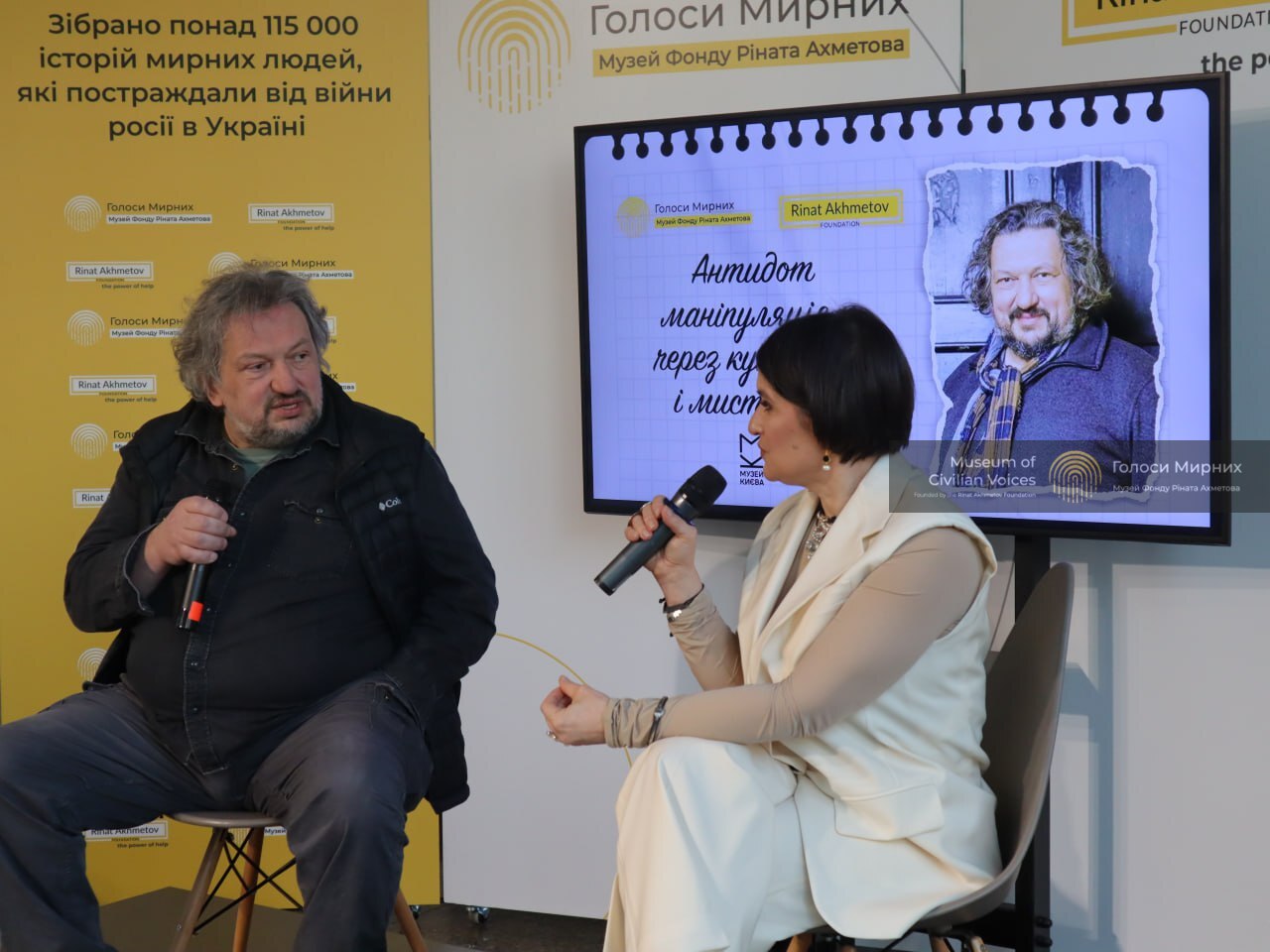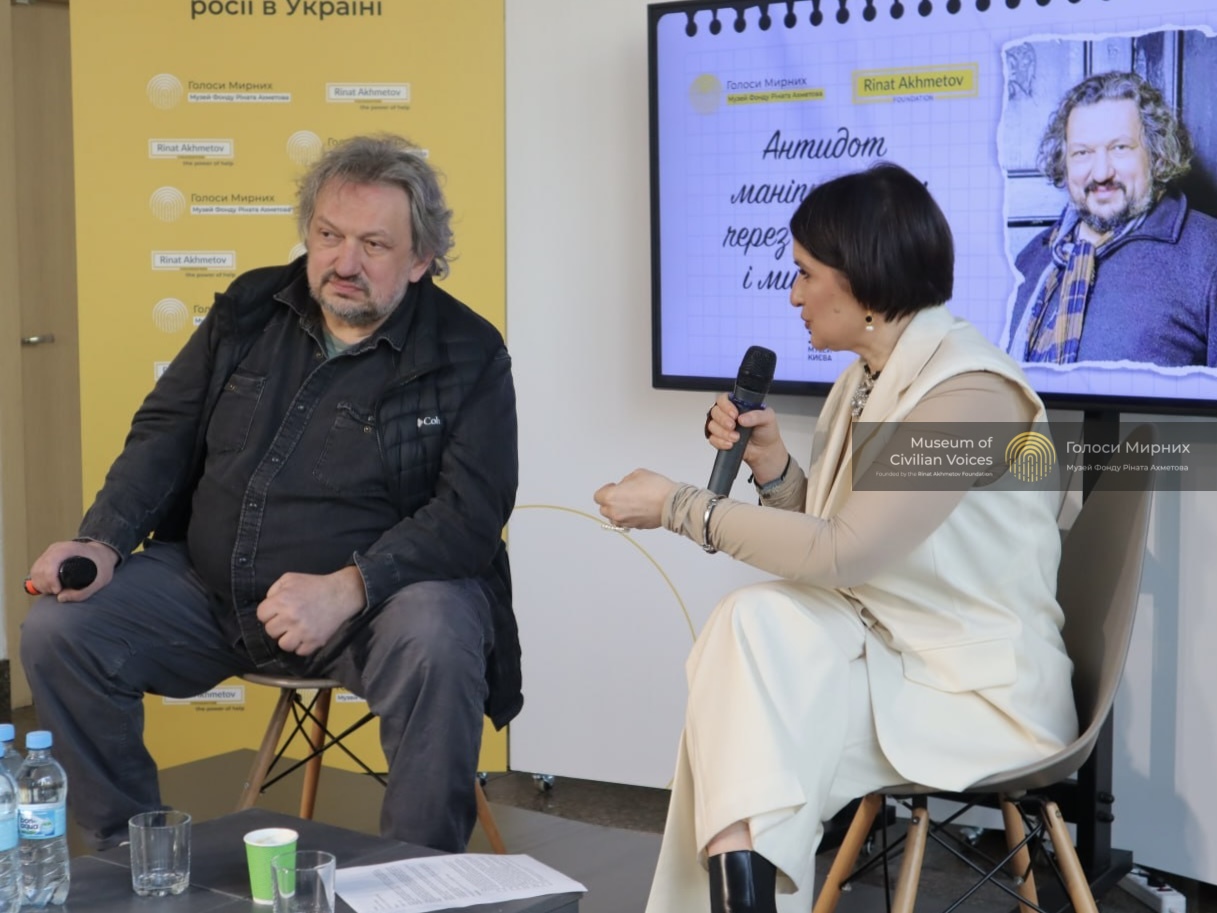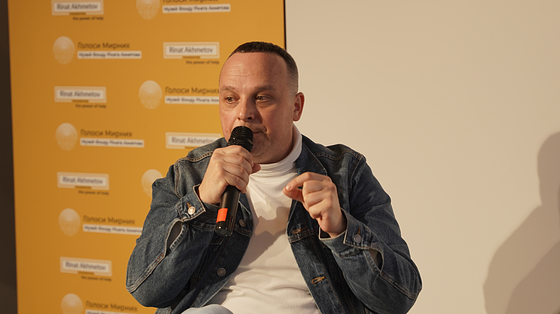Vlad Troitskyi: “A tradition of genesis awareness is beginning to form in Ukraine”
An interview with theatre director Vlad Troitskyi for the Museum of Civilian Voices founded by Rinat Akhmetov Foundation.
The Kyiv History Museum is hosting the exhibition “Diaries of the Civilians: Voices of those who survived and those who did not”. This is a documentary project of the Museum of Civilian Voices founded by the Rinat Akhmetov Foundation, which collects and stores the world’s largest collection of accounts of the war in Ukraine. So far, the Museum has collected more than 130,000 stories.
As part of the exhibition, a public interview with Vlad Troitskyi, theatre director, founder of the Dakh Theatre and the GOGOLFEST festival, leader of the Dakh Daughters, Dakhabrakha, and Nova Opera music projects, took place.
The topic of the conversation is “Antidote to Manipulation through Culture and Art”. During the conversation, they discussed various aspects of the culture of memory, the subtleties of the formation of the Ukrainian myth and the role of art in the struggle during the war.
The interview was moderated by Nataliia Yemchenko, Communications Director of System Capital Management, member of the Supervisory Board of the Rinat Akhmetov Foundation.

Nataliia Yemchenko: A year ago, we presented the multimedia space of the Museum of Civilian Voices founded by Rinat Akhmetov Foundation. The immersive exhibition VOICES, which was visited by thousands of people, was realised with the production support of Vlad Troitskyi, and we are very grateful for this cooperation. This leads to the first question: what is the culture of memory in the context of preserving the truth about the war?
Vlad Troitskyi: Memory is a part of culture.
In 2024, as part of the Gogolfest. Pokrova festival in Zaporizhzhia, we implemented a project, an installation dedicated to the fallen defenders of Ukraine, called the Tree of Memory. During its creation, I heard messages that memorialisation should be done after the war.
I strongly disagree with this. Because it is important for both the relatives of the deceased and their fellow soldiers to understand that you are respected. This respect can be shown by organising a certain place, not a cemetery, but a public space where people can live through both sadness and hope.
By not remembering, you destroy your dignity, because you destroy the tuning fork that unites citizens and gives them the feeling that we are a country with dignity, respect and humanity.
In the modern world, values are being destroyed – we are all witnessing how what was recently a model is no longer so. In some countries, extreme right-wing forces with their radical slogans are winning.
Many current processes are reminiscent of those that preceded the Second World War. On the one hand, there is a fear in Europe that history might repeat itself. On the other hand, there is no realisation that it is already happening.
We need to understand that all this is part of our memory. But this memory needs to be rethought and transformed to better understand the processes around us.
Nataliia Yemchenko: What role should culture and the arts play in the struggle in times of war?
Vlad Troitskyi: The word “should” is not very appropriate – it is “desirable”. It is desirable for culture and arts to be a tuning fork.
Everyone is under a lot of stress now, everyone needs to be able to exhale. A person goes to a creative event just to distract themselves and not think about the war for at least a few hours.
Today, lectures or instructions don’t work – no one likes preaching or mentoring. But when you touch feelings through art, when people start thinking with their hearts, it is at this moment that an inner tuning fork can be built. The next stage is to tune these tuning forks to create a polyphonic symphony.
Nataliia Yemchenko: How to form a modern Ukrainian myth?
Vlad Troitskyi: Only with the help of art. The myth of modern Ukraine has not yet been crystallised.
We are dealing with a systemic enemy who uses sophisticated technologies and Jesuit methods of destroying society, both here and abroad, in order to divide and fragment it.
It is the role of artists to understand this danger, but also to understand that the tragic story continues. You work with a memory that you cannot fix. It cannot be covered with concrete, it has to be open source, with the realisation that everything is in development.
In addition, the world does not like victims and unfortunates, the world loves heroes. It doesn’t matter whether you are a winner in a war or not, the main thing is that you are a hero. The three hundred Spartans lost their battle, but we remember them, and from the point of view of myth, they are winners.
Another example is the case of the Jewish people. We can say-with all due respect-that they made a myth out of the Holocaust. Today, it is a global narrative, a word that is in the vocabulary of the whole world. This is a huge sacrifice, but at the same time, no one perceives Jews as victims – they are heroes.
We desperately need the myth of the victor, and there is a basis for it. For me, it is a real miracle that Ukraine has survived in 2022. We don’t remember much about 2014 now, but back then, there was almost no chance that a number of cities would survive. There are many people behind this miracle, heroes who created this story of victory.
Nataliia Yemchenko: How to counter the myth of the “great russian culture”?
Vlad Troitskyi: There is only one way: to build your own Ukrainian myth, and at the same time to systematically destroy the myth of russian culture, which is completely artificial.
But you have to be very careful here, because cancel culture in this context may be perceived in Ukraine, but if you assert it abroad, you will look like an offended person and automatically lose.
It’s always about analysis and facts. When I talk to journalists or cultural figures abroad, I emphasise that until the beginning of the twentieth century, no one in Europe or the world knew anything about russian literature, for example.
It was only in the twentieth century that its promotion began. In the soviet union, there were technologists who used the left-wing sentiment in Western society, and it was through this sentiment that russian culture was pushed.
Then came rossotrudnichestvo. Until 2008, this organisation, with a developed infrastructure of institutions, had different names, but not the essence: it was to promote russian music, literature, ballet, etc. It was here that the system of so-called “useful idiots” emerged. The author of this term, which has not lost its relevance, is lenin.
And there are things to learn from the enemy. For example, a lot of russian artists fled russia. But russia still always “labels” them as part of its culture.

Nataliia Yemchenko: Especially after their death.
Vlad Troitskyi: Yes. And sometimes we allow ourselves to say something like “Gogol is not ours”. How is he not ours?!
If we analyse his work, we will see that the main characters of the Little russian Cycle, including Evenings on a Farm, The Viy, The Night Before Christmas, etc. are strong, deep people. Scary, but real and alive.
And when he starts working in St. Petersburg, in his novels The Overcoat and The Nose, he creates some kind of “trash”, “bad”, not a human being. One of the russian critics said: “We all came out of Gogol’s Overcoat”. This is a scary phrase if you think about it. Because who is Akakii Akakiiovych? Would you like to have common features with him as a person? I’m sorry, I wouldn’t.
In general, all russian literature is about “unnecessary”, “superfluous” people. There is not a single positive hero. And this is its uniqueness.
Nataliia Yemchenko: What would be the right thing for Ukraine to do to ensure that our culture not only plays a major role, but also allows us to survive, win and preserve our historical memory?
Vlad Troitskyi: Culture and arts are a powerful weapon, and it should be treated as such – as a strategic industry. It’s not a question of money, it’s a question of attitude and understanding: whether it is just an entertainment industry or a foundation that shapes society and creates myths that unite the state and people.
We are just beginning to build a tradition of understanding our genesis. For example, over the past few years, we have managed to open up the story of the Executed Renaissance to the general public and show that it was a powerful movement, not a bunch of strange artists.
At the same time, there are many examples of a post-soviet approach to presenting history – we don’t always realise whose shoulders we stand on, who are our teachers?
The same figures of Lesia Ukrainka, Ivan Franko, and many others are now “cast in concrete” – that is, memorialised but not open to contemporary culture.
Or the story of the Theatre of Coryphaei. It was this theatre that inspired Stanislavski to create the Moscow Art Theatre. In other words, it was originally a case of Ukrainian artists, but the soviet union deliberately destroyed the story of the Theatre of Coryphaei.
Before the Second World War, there was an incredibly strong cultural movement in Ukraine. About 100 (!) thick literary magazines were published in Kharkiv, the Ukrainian capital at the time. At the same time, there were more than 100 theatres in Kyiv, and this was despite the fact that the population was much smaller than it is now, around 300-400 thousand people – now there are approximately 5 million people living here, and no more than 50 theatres.
Nataliia Yemchenko: This is about memory – we were taught not to remember.
Vlad Troitskyi: Yes. There is a widespread belief that Ukrainian culture was originally “artisanal”: it was created by talented person who learnt everything on their own. But this is not true.
You need to know who your teacher is, what tradition is behind you, how they intersect, and how new generations emerge from them. This is extremely important.
Nataliia Yemchenko: That is, when contemporary art refers to themes from the past, it is not about sentiment, it is about reclaiming memory and a part of the myth. Which contemporary artists’ work stands out in this context?
Vlad Troitskyi: Ukrainian literature is now in full bloom. Among my personal favourite authors are Taras Prokhasko, Yurii Izdryk, Myroslav Laiuk, all of whom are fantastic writers. Of course, Serhii Zhadan is an extraordinary figure, both as a writer and as a public figure.
There are many bright young poets and musicians, such as Pyrih i Batih, Schmalhausen and others.
I can’t help but mention the band Dakhabrakha. Their phenomenon is that their ethnic roots – the energy of the earth, concentrated in folklore – are superimposed on the thinking of modern academic music, combined with overtones of world folklore, and generally give an urban sound. It’s like a cut that emphasises a diamond.
Nowadays, the Ukrainian musical tradition of the 1960s is being rediscovered - the singer Mariana Holovko, in particular, is doing this, and Sofiika Baskakova from Dakh is also doing it. It’s not just about high-quality arrangements, but about rethinking the music and setting it up for the future.
Nataliia Yemchenko: And in terms of theatre? Now everyone is talking about the stage director Ivan Uryvskyi...
Vlad Troitskyi: I am very happy that the myth of the great Ukrainian theatre has finally appeared. I don’t discuss taste – whether I personally like something or not. But I have a lot of respect for what Ivan Uryvskyi, Davyd Petrosian, Tamara Trunova, and Maks Holenko, among others, are doing.
At the same time, I have an understanding of contemporary academic Ukrainian music – there are many world-class composers.
Nataliia Yemchenko: The myth of art is a great weapon. What is the role of art in preserving the truth?
Vlad Troitskyi: Truth is an existential and difficult concept.
We’ve all heard the abbreviation PSYOP, but few people understand the essence of this phenomenon. I myself used to perceive this term quite primitively, as a fake or information throw-in, until I researched the issue.
In the 1960s, the movement of so-called methodologists began in the USSR. Among its inspirers was the philosopher Heorhii Shchedrovitskyi. Later, his son worked closely with Serhii Kyriienko, a young prime minister under Yeltsin and now a grey cardinal in the Kremlin. The essence of the system is this: there is a think tank that looks for triggers, pain points in society – it uses organic triggers or creates artificial ones. And it systematically puts pressure on them from different sides. And this is done not under the russian flag, but rather under the guise of “one of their own”. The theme can be any: patriotic – for the motherland-Ukraine-Germany-Hungary, environmental, LGBT, human rights... Anything that evokes strong emotions is used.
The goal is to fragment society as much as possible, to form isolated “bubbles”. Because a person, constantly receiving pressure on the “wound”, ceases to perceive reality adequately and reacts only to pain.
Nataliia Yemchenko: So it is essentially about reflexive management?
Vlad Troitskyi: Yes, this is the second name for this methodology. The Americans also tried to work with similar techniques, but they focused on the elite. The russians work with people from remote areas, and in this case, they really succeed in creating these bubbles: people constantly feel that they have no way out and that there is only bad news everywhere.
These speculations, which began in the twentieth century, are still present today – we can clearly see fringe movements that implement these methodologies, sometimes giving money to promote them. The goal is to prepare the ground for the emergence and strengthening of “false tuning forks” in society.

Nataliia Yemchenko: You are currently launching the Antidote project. Tell us what it is about, what is its idea?
Vlad Troitskyi: This is not a project, but rather a movement that will have many directions. Its main task is to inoculate society against manipulation through art.
First of all, it is about developing critical thinking. After all, refutation or fact-checking often, on the contrary, increase the influence of technologies that have been honed over decades. And art, I repeat, always touches emotions, and therefore this experience is definitely memorable.
The first component of this movement is the artistic one. At the end of a performance, concert, or exhibition, there will always be an explanation of what facts were used and why we should be careful with information.
The second part is the awakening of the humanity’s tuning fork, the revival of values that are now being destroyed, from “respect” and “compassion” to “politeness”. They are awakened when you first manage to touch the heart – and then talk through your feelings.
This leads to another component of the Antidote programme: developing a culture of dialogue. Who in our country teaches people not only to speak but also to hear the other? In real life, we often communicate with a function rather than a person. Even in our own family – “wife”, “father”, etc. Seeing the other – and hearing them – is a daily job.
In addition, there are many rifts in society today – between civilians and the military, between those who left and those who stayed. Therefore, one of the directions will be devoted to healing these rifts – creating an umbrella that will help people get through this period in their lives and history.
.png)





.png)



